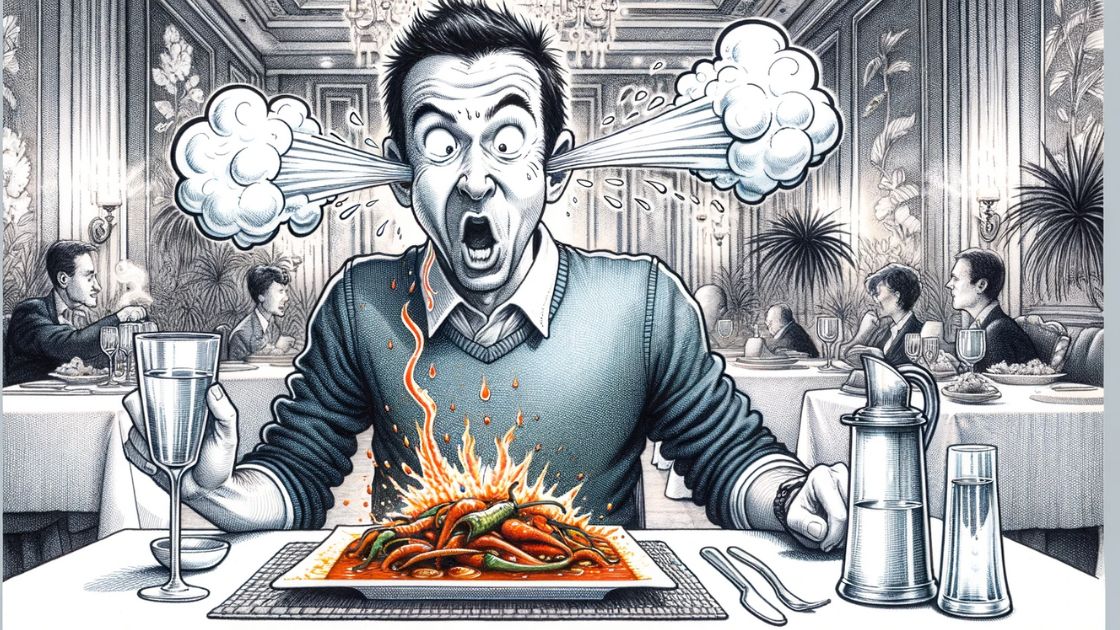Some people thrive on spicy foods — eating the ghost pepper salsa or ordering the ‘nuclear’ hot wings.
Are these people just tougher? stronger? superior? Or are they genetic oddities? Personally, I say that there is no shame in being a spicy food wimp! Members will see their genotype report below, plus additional solutions in the Lifehacks section. Join today.
TRPV1 receptor
Every perception we feel – heat, cold, salty, pain, acid, etc – is caused by a receptor sending a message. Your body has a number of different receptors that govern how you perceive the world.
Capsaicin and feeling the heat from spicy foods
Capsaicin is the component of chili peppers that makes them spicy and hot.
Capsaicin binds to a specific receptor called the TRPV1 receptor, which gives us the perception of heat and pain from spicy foods.
TRPV1 stands for transient receptor potential vanilloid 1. The main function of this receptor is not to make us cry when eating spicy foods — instead, it is involved in body temperature regulation.
TRPV1 is activated by[ref]:
- temperatures greater than 43 °C (109 °F)
- capsaicin (spicy peppers)
- isothiocyanate (wasabi and mustard compounds )
- peperine (black pepper)
- gingerol (ginger)
- voltage
- acidic conditions (pH < 5.9)
- spider, centipede, and tarantula venom[ref]
- cannabidiol (CBD oil) at certain doses[ref]
- compounds in the body such as AEA, leukotriene B4
What does the TRPV1 receptor do?
The TRPV1 receptors are mainly found in the peripheral nervous system in the nociceptive (pain-sensing) neurons.[ref]
Capsaicin causes you to feel heat and pain by activating the pain receptors in the peripheral nervous system. But repeated exposure to capsaicin will decrease the TRPV1 receptor activity, causing you to be less sensitive to pain.
Repeated exposure to spicy foods decreases the receptor, making the food tasteless spicy. Another way that repeated exposure can be used is through using capsaicin cream for arthritis pain. Repeated exposure decreases the TRPV1 receptors, which decreases the perception of pain in arthritis.
Beyond pain and spicy food:
Beyond just signaling pain, the TRPV1 receptor plays other important roles within the body.
TRPV1 is important in the cardiovascular system and in insulin release.[ref][ref]
TRPV1 activation increases insulin sensitivity and is therefore involved in energy expenditure and diabetes.[ref][ref]
Appetite regulation may be influenced by TRPV1, and it may be dysregulated in people with obesity.[ref]
Endocannabinoids, CBD (cannabiodiol) oil, and terpenes in cannabinoids can bind to the TRPV1 receptor. This is how they modulate pain.[ref]
Related article: CBD Oil and Genetics
The TRPV1 receptor may be involved in hot flashes in menopause.[ref]
TRPV1 Genotype Report:
Members: Log in to see your data below.
Not a member? Join here.
Why is this section is now only for members? Here’s why…
Lifehacks:
If you have ever started dripping with sweat after eating something spicy, there is a name for this — gustatory sweating – and it is caused by the thermoregulation of TRPV1.[ref] This thermoregulation is thought to be why eating spicy foods in a hot climate ends up cooling you off (theoretically).[ref]
6 things can you do if you are a spicy food wimp:
Related Articles and Topics:
Digesting Carbohydrates: Amylase variants
Carbohydrate digestion begins in the mouth with an enzyme called amylase. Saliva mixes with your food as you chew it, and the amylase in saliva begins breaking down carbohydrates into simple sugars. Amylase is also produced by the pancreas and used for further breaking down carbs in the small intestines.
Lactose Intolerance: The genetics of not producing lactase
Are you a milk drinker? Does pouring a cold glass of milk sounds good? Your genes control whether you are likely to produce lactase as an adult, and it is easy to check your 23andMe or other genetic data to see if you are likely to enjoy a big glass of milk.
BDNF + Serotonin Variants: Increased risk of depression and anxiety
Genetic variants in the BDNF and serotonin receptor genes combine to increase the risk of depression and anxiety. Learn more about BDNF and how these variants interact — and check your genetic data to see how this applies to you..

